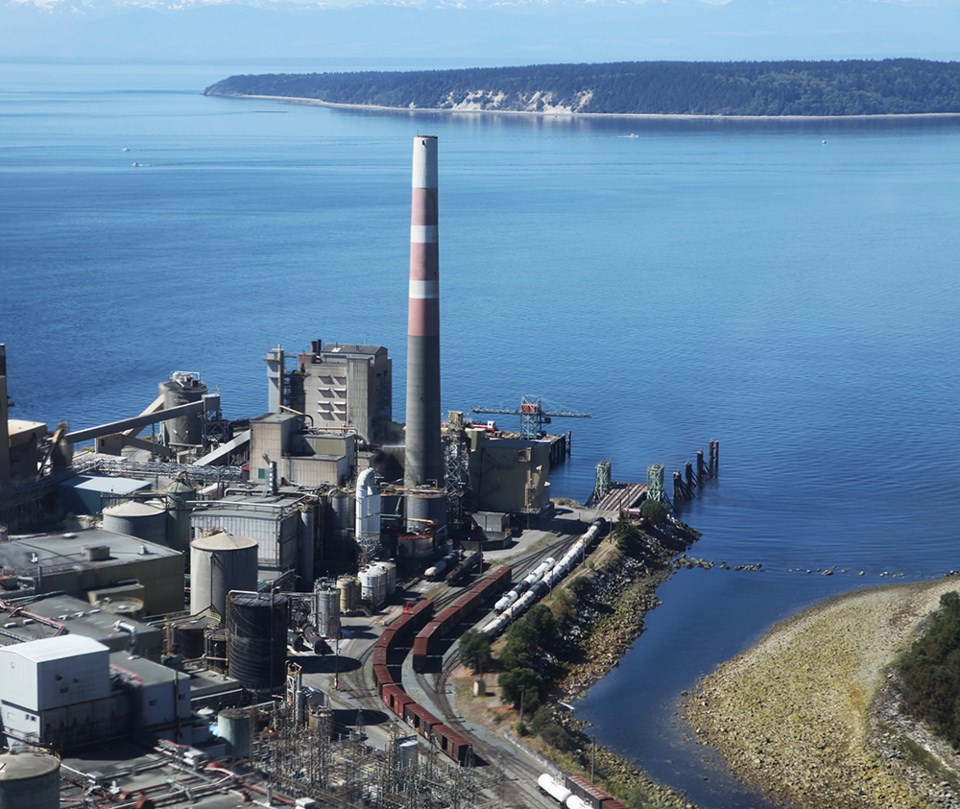A Tla’amin Nation reacquisition of Tis’kwat (old mill site) in Townsite would present significant environmental and economic opportunities, and prevent the site from being stripped and abandoned, according to a Tla’amin executive council member.
On September 15, the nation released a statement reading: “Tla’amin Nation has sent a letter of intent (LOI) to Paper Excellence (PE) in accordance with the company’s deadline for parties interested in purchasing the 300 acre mill site at Tis’kwat and all of its industrial assets.”
In an accompanying statement, Tla’amin hegus John Hackett said: “More than 100 years ago, our people were forced from our ancient village at Tis’kwat. Our people have never benefitted in any way from the many millions of dollars extracted from the mill that was built over our village. We have never relinquished our claim to what was once a beautiful place, with a thriving sockeye salmon run.
“As we move toward an offer to purchase the site and reacquire our traditional lands and waters, we celebrate the resilience, strength and determination of our people.”
Tla’amin executive council member Dillon Johnson told the Peak that Tis’kwat is a deeply important place to Tla’amin people.
“Tis’kwat was Tla’amin’s main city site, and our people lived there for thousands of years. It’s only been 140 years since our people were forcibly removed,” he explained.
He noted that Tla’amin’s treaty with Canada and BC explicitly protects the nation’s claim to Tis’kwat. It reads: “Nothing in this agreement precludes the Tla'amin Nation from pursuing any claims, including any claims respecting Tis’kwat, that fall within the scope of Canada’s Specific Claims Policy…or in court.”
“We’ve never relinquished that claim; it was never something that our people were just going to let go in the treaty,” said Johnson. “We just never had an opportunity, like what exists right now, where we could actually get the land back. It has been our position throughout the mill site transition process that all roads to Tis’kwat lead through Tla’amin.”
“We are the most logical entity to own the site and we have assembled a team of professionals to evaluate and develop a responsible, diligent plan for the site.”
He explained it has been six generations since Tla’amin people were originally moved from the Tis’kwat site.
“We don’t intend to reclaim it and say, ‘let’s make it back to what it was,’ because that’s just not practical now, but we don’t want to fire it up as a paper mill,” added Johnson. “Clearly it’s not financially viable.”
Green energy opportunity
Instead, Tla’amin sees a potential opportunity to pivot the site toward green energy production, creating local jobs in an environmentally responsible way.
“It has all the characteristics that make for a good, green hydrogen site,” said Johnson.
The September 15 statement noted that “positive discussions with Pacific Hydrogen Canada Corp are ongoing further to the memorandum of understanding announced on August 17 with regard to a possible clean, green energy project at Tis’kwat.”
There is potential for additional economic opportunities, such as value-added forestry products and land-based aquaculture, added Johnson.
“Equally as important is it would give us a better position to advance a salmon ladder to help restore the sockeye run,” he said.
In addition to presenting environmental and economic opportunities, Johnson said Tla’amin reclaiming Tis’kwat would avoid a “worst case scenario” in which a multinational corporation purchases the site and salvages anything of value before leaving town and abandoning the site in a poor environmental condition.
He noted that shell companies have been known to buy up industrial sites, declare bankruptcy and shirk responsibility for the cleanup, leaving the province and local community holding the bag. The ongoing cleanup of the Neucel pulp mill in Port Alice provides a pertinent example, he said.
“That’s something everybody can take some comfort in. If we do acquire it, we’re not just going to abandon this; we’re here to stay,” added Johnson, who explained that the Tla’amin people’s connection to Tis’kwat “can’t really be described in words.”
“We have that connection; we want to lead what happens down there and we’re going to do it in a way that manages the risks to our nation as best we can,” he said. “We’re not just going to take a blind leap.”
Johnson said Tla’amin is currently waiting for a response from the site’s current owners regarding the nation’s LOI. He has heard concerns expressed locally that Tla’amin ownership of the site would remove it from the city’s tax base, but such concerns amount to a “false fear,” he added.
“It’s not a real, legitimate concern, because in order to add anything to our tax base from the city’s tax base, that actually requires the consent of the city,” explained Johnson. “Regardless, I hope that people will see the benefit in local ownership. The community has been okay with these big corporations buying it and generating whatever profits they can, which go to offshore accounts or to shareholders around the world.
“If there are any profits that come from our involvement, people can be rest assured that those benefits will be experienced locally.”



